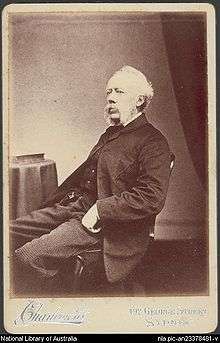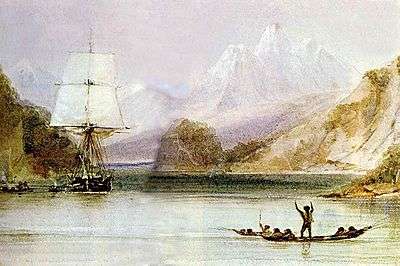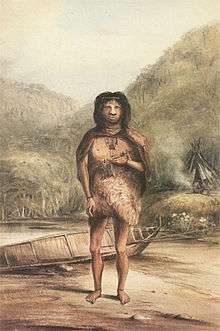Conrad Martens
| Conrad Martens | |
|---|---|
 Portrait of Conrad Martens, National Library of Australia | |
| Born |
1801 London, England |
| Died |
21 Aug 1878 (aged 76–77) North Sydney, New South Wales, Australia |
| Known for | Watercolour painting |
Conrad Martens (London 1801 – 21 August 1878) was an English-born landscape painter active on HMS Beagle from 1833, and in Australia from 1835.
Life and work
Conrad Martens' father was a merchant who came originally to London as Austrian Consul; Conrad was born in "Crutched Friars" near Tower Hill. Like his two brothers, John William and Henry, he studied landscape painting under the prominent watercolourist Copley Fielding.
In 1832 he joined the ship Hyacinth as a topographical artist. In Montevideo near the end of 1833 he met Robert FitzRoy, captain of HMS Beagle, who engaged him as a draughtsman to replace the ship's artist Augustus Earle who had fallen ill. In this way he joined the second voyage of HMS Beagle and soon struck up a lifelong friendship with Charles Darwin who was taking part in the expedition as a self-financing gentleman naturalist and companion to the captain. They sailed south to Patagonia. Martens left the Beagle at Valparaiso in the second half of 1834 and took passage to Sydney via Tahiti, arriving in 1835.


Martens was introduced to the New South Wales gentry and soon achieved success in Sydney with several commissions. He went on to become the most proficient, prominent and prolific landscape artist in the colony. The Beagle arrived in 1836, and Darwin and Captain Fitzroy commissioned a number of paintings from the Beagle's voyages in Tierra Del Fuego and the Pacific. Other large commissions followed, and in 1837 some of Martens' Australian watercolours were exhibited at the Royal Society in London. In 1839, however, a drought triggered an economic recession which was to last until the 1850s, and commissions became increasingly difficult to acquire. In the 1840s he turned to lithographs, which allowed him to sell the same work many times over - his 'View of Sydney from the North Shore' was especially popular.[1]
Conrad Martens married Jane Carter, of Welsh heritage and the only child of William and Jane Carter at St James Church, Sydney, on 9 March 1837. Jane's father, a private barrister and first Master in Chancery of the Supreme Court of NSW had purchased one of Martens' paintings, View of Tahiti in September 1836.[2]
In late 1851 Martens sailed to Brisbane, travelling back via road, across the Great Dividing Range to the Darling Downs, then south through New England to Sydney. En route, he lodged with squatters and pastoralists, drawing their houses and properties, and hoping for commissions.[3] The plan succeeded, and Martens was eventually commissioned to paint over seventy watercolours, nearly forty of which are still known today.
He exhibited at the Victorian Fine Arts Society in Melbourne in 1853, and at the Paris Universal Exhibition in 1855. Eventual improvement in the Australian economy in the later 1850s (largely due to the discovery of gold) led to an increase in significant commissions. A famous painting is North Head, Sydney Harbour (1854).
In 1862 he received a message from Darwin, and replied congratulating him on the success of The Origin of Species.[4] He sent Darwin a watercolour of Brisbane River and exhibited at the International Exhibition in London. In 1863 he became Assistant Librarian in the Parliamentary Library, securing his financial position, but severely curtailing the time he could spend on artistic work. Nevertheless, he exhibited at the Paris International Exhibition in 1867. He received his first public commission in 1872, from the Victorian Gallery (later National Gallery of Victoria), for a watercolour of Apsley Falls on Waterloo (Pastoral) Station, near Walcha, New South Wales, and a second similar commission in 1875[5] from the New South Wales Academy of Arts (later Art Gallery of New South Wales), of whose Council he became a member in 1877.
From the later 1860s Martens suffered from angina, and he died from a heart attack on 21 August 1878. He is buried at St Thomas cemetery, North Sydney.[6]
See also
References
- Richard Keynes. Fossils, Finches and Fuegians: Charles Darwin's Adventures and Discoveries on the Beagle, 1832-1836. (London: HarperCollins, 2002) ISBN 0-00-710189-9. This book contains several reproductions of Martens' work.
Further reading
- Douglas Dundas. Martens, Conrad (1801–1878) - Australian Dictionary of Biography, Volume 2 (Melbourne University Press, 1967) pp 212–213.
- Susanna de Vries. Conrad Martens on the Beagle and in Australia (Pandanus Press, 1993). ISBN 0-646-14129-5.
References
- ↑ Archived 15 February 2005 at the Wayback Machine.
- ↑ Ellis, Elizabeth (1994). Conrad Martens Life and Art. Sydney: State Library of NSW Press. p. 27. ISBN 0 7305 8917 X.
- ↑ Ellis, Elizabeth (1994). Conrad Martens Life and Art. Sydney: State Library of NSW Press. p. 58. ISBN 0 7305 8917 X.
- ↑ Martens, Conrad. "Letter 3398, Martens, Conrad to Darwin, C. R. 20 Jan 1862". Darwin Correspondence Project. Retrieved 4 April 2014.
- ↑ Martens, Conrad (1874). "Apsley Falls". AGNSW collection record. Art Gallery of New South Wales. Retrieved 10 May 2016.
- ↑ Dundas, Douglas. Martens, Conrad (1801–1878). Canberra: National Centre of Biography, Australian National University.
External links
| Wikimedia Commons has media related to Conrad Martens. |
- Conrad Martens at the Art Gallery of New South Wales
- Works by Martens (National Library of Australia, Canberra)
- Conrad Martens (State Library of New South Wales, Sydney)
- The Conrad Martens sketchbooks - illustrations of the voyage (Cambridge University Library's Digital Image Collections). Includes sketches made as a member of the HMS Beagle crew.
- Conrad Martens: The second voyage of the HMS 'Beagle' (National Maritime Museum)
- Forest, Cunningham's Gap (Watercolour, 1856 - Queensland Art Gallery)